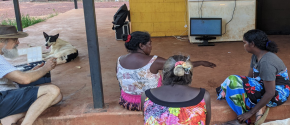Communication is the fundamental key to learning and mutual understanding, and yet when it comes to cross-cultural communication, we still seem to have the equivalent of a colonial mindset in certain situations. We often still believe that Aboriginal people should be the ones adjusting to the Western way of learning rather than professionals in government, health care and education making adjustments to understand their way.
Richard Trudgen was working with a Yolngu interpreter at the Royal Darwin Hospital. One day she said
“Richard, can I ask you a question? What does the word ‘percentage’ mean?”
Richard asked whether she had any pictures in her head when she heard that word.
“None at all,” she admitted.
“How was this word used?” Richard asked her.
“A doctor said ‘2 percent’ and something to do with kidneys.”
“Ah, that must have been something to do with the phrase ‘only 2 percent kidney function’?”
“Yes, that’s it!” she said.
While it’s easy to translate tangible words such as ‘tree’, ‘cup’, ‘stand’, ‘sit’, etc., into another language, words that describe academic concepts can easily be lost. For example, the English word ‘serious’ is translated by Yolngu people as ‘terminal’ or ‘you’re gonna die soon’. There are thousands of other concept words, especially in government and health care situations, that affect the lives of indigenous people.
Richard drew a kidney for the Yolngu woman on a piece of paper. Then he drew ten lines down it and ten lines across.
“This is a kidney with 100 boxes over it,” he explained. “What the doctor was talking about was just 2 of these boxes inside the kidney are good and functioning. But the rest is no good.”
Suddenly the woman broke down and started to cry.
“Was this is one of your relatives?” Richard asked gently.
“Yes, my sister.”
“Has she gone already?”
“Yes, she didn’t last long after that. I wish I’d known what the doctor meant.”
The Yolngu woman stopped being an interpreter that day and went home. She felt she had failed her sister and played a part in her early death – because of a breakdown in cross-cultural communication.
Until professionals question whether Aboriginal people understand the concept under discussion and brief interpreters who work with them on the concepts they are trying to communicate, then how will we ever close the gap?
Richard Trudgen
Watch the full story on our Q&A video here.
For the Yolngu Matha explanation on ‘what is percentage’, visit our podcast here.



